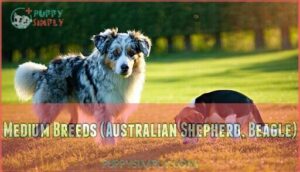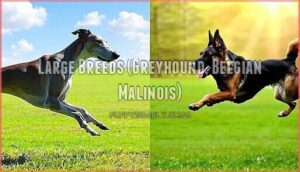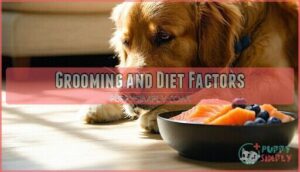This site is supported by our readers. We may earn a commission, at no cost to you, if you purchase through links.

These breeds benefit from responsible breeding practices and genetic health screening that examines over 270 genetic risks. The secret lies in matching your lifestyle with their specific needs for ideal health outcomes.
Table Of Contents
- Key Takeaways
- How Are The Healthiest Dog Breeds Identified?
- Top Dog Breeds With Exceptional Longevity
- Healthiest Dog Breeds by Size
- Breed-Specific Health and Lifestyle Considerations
- Choosing The Right Healthy Breed for Your Lifestyle
- Frequently Asked Questions (FAQs)
- What are the exercise needs and requirements for an Australian Shepherd?
- What are the common health issues or conditions that Greyhounds are prone to?
- What vaccinations do healthy dog breeds need?
- How much do healthy breeds typically cost?
- Which healthy breeds are hypoallergenic for allergies?
- Can healthy breeds live in apartments successfully?
- Conclusion
Key Takeaways
- You’ll get the longest companionship with Australian Cattle Dogs and Poodles – these breeds consistently live 12-16 years, with some Australian Cattle Dogs reaching nearly 30 years, while Poodles average 12-15 years and have fewer genetic problems.
- You need to match your energy level with your breed’s exercise requirements – high-energy breeds like Australian Shepherds need 2+ hours of daily exercise, while lower-maintenance options like Basenjis adapt well to apartments with moderate activity needs.
- You should prioritize breeders who conduct genetic health screening – modern DNA tests examine over 270 genetic health risks, helping you avoid inherited conditions like hip dysplasia and eye diseases before they become problems.
- You can find healthy options in every size category – from tiny Chihuahuas living up to 20 years to large Greyhounds with 10-13 year lifespans, each size group offers breeds with fewer genetic problems when you choose responsibly.
How Are The Healthiest Dog Breeds Identified?
When you’re looking for the healthiest dog breeds, experts rely on three key sources to make these determinations.
Veterinarians and breeders provide reports on common health issues, the American Kennel Club maintains detailed breed health records, and genetic health screening identifies inherited conditions before they become problems.
Breeder and Veterinary Reports
Breeder reputation and veterinary oversight form the backbone of identifying the healthiest dog breeds. These health-focused partnerships track breed-specific problems through systematic data collection. Many breeds, like the Australian Cattle Dog, are known for their outstanding health and longevity.
- Health Certifications – Ethical breeders require genetic testing and screening before breeding
- Veterinary Records – Ongoing vet care documents disease patterns across breed lines
- Breed Standards – Professional guidelines guarantee responsible breeding practices prioritize health over appearance
Role of The American Kennel Club
The American Kennel Club acts as your go-to authority for identifying the healthiest dog breeds. AKC Breed Standards outline specific health requirements, while their Health Initiatives fund genetic research. Through breeder education and advocacy efforts, the AKC maintains thorough health databases tracking dog breeds’ genetic profiles and health outcomes.
| AKC Health Program | Purpose | Impact on Dog Health |
|---|---|---|
| Genetic Research | Fund canine disease studies | Prevents inherited conditions |
| Breed Standards | Define health requirements | Ensures breeding quality |
| Health Testing | Screen for genetic disorders | Identifies healthy bloodlines |
| Educational Programs | Train responsible breeders | Promotes healthiest dog breeds |
Genetic Health Screening
Modern genetic health screening gives you a powerful window into your dog’s future health. DNA tests now examine over 270 genetic health risks using more than 230,000 genetic markers, helping identify genetic predispositions before symptoms appear. These tests offer insight into a dog’s breed composition, providing scientific facts about ancestry.
Here’s what genetic screening reveals:
- Early detection of inherited conditions like hip dysplasia and eye diseases
- Screening methods that identify carriers before breeding decisions
- Responsible breeding practices that reduce genetic conditions in future litters
- Ethical implications for choosing healthiest dog breeds with fewer health problems
Top Dog Breeds With Exceptional Longevity
When you’re looking for a four-legged companion that’ll stick around for years, certain breeds consistently outlive others by significant margins.
These long-lived champions, including Australian Cattle Dogs that can reach nearly 30 years and Chihuahuas approaching 20, offer you the best chance for extended companionship with fewer health complications.
Australian Cattle Dog
You’ll find the Australian Cattle Dog topping healthiest dog breeds lists for good reason. With lifespans reaching 12-16 years, these hardy workers showcase outstanding longevity. The breed record holder, Bluey, lived an astounding 29 years! Their cattle dog agility and herding instinct care needs reflect their working heritage, while ACD temperament traits include intelligence and loyalty.
| Health Aspect | Australian Cattle Dog | Comparison to Average |
|---|---|---|
| Lifespan | 12-16 years | Above 12.7 year average |
| Deafness Rate | 10-20% affected | Moderate genetic concern |
| Hip Dysplasia | Low occurrence | Better than many breeds |
| Exercise Needs | 2+ hours daily | High energy requirements |
| Genetic Diversity | Excellent (dingo ancestry) | Exceptional breed health |
These Australian Cattle Dog champions need extensive cattle dog training and mental stimulation. Their ACD breed history includes dingo crossings, creating sturdy genetics. Regular screening catches issues like progressive retinal atrophy early, ensuring your active companion stays healthy throughout their impressive lifespan.
Chihuahua
Tiny powerhouses, Chihuahuas boast impressive longevity among the healthiest dog breeds. Their chihuahua lifespan averages 12-18 years, with some reaching 20. However, chihuahua health requires attention to prevent chihuahua obesity through proper chihuahua diet and regular chihuahua exercise.
Key chihuahua health issues include:
- Dental disease affecting 13.5-19% of the breed
- Heart conditions in older dogs
- Patellar luxation causing knee instability
Poodle
Poodles stand as champions among the healthiest dog breeds, with impressive poodle lifespans averaging 12-15 years. These intelligent companions need consistent poodle exercise and mental stimulation to thrive. While poodle health generally excels, watch for hip dysplasia and Addison’s disease.
Smaller breeds such as poodles often exhibit notable canine longevity, contributing to their appeal. Their hypoallergenic coats require regular poodle grooming, but proper poodle diet and care reward you with decades of loyal companionship from these exceptional dogs.
Basenji
The Basenji stands out among the healthiest dog breeds, boasting an impressive 13.6-year median lifespan. This rare breed’s independent nature and unique yodeling sounds make them fascinating companions. Their minimal grooming needs add to their appeal.
Key health advantages include:
- 30% die from old age rather than disease
- Low hip dysplasia rates (just 3%)
- Excellent genetic diversity from ancient lineage
While Fanconi syndrome affects 10% of Basenjis, responsible breeding and DNA testing help minimize this risk.
Healthiest Dog Breeds by Size
You’ll find healthy breeds in every size category, from tiny Chihuahuas that can live nearly 20 years to sturdy Greyhounds with their 10-13 year lifespans.
Whether you’re looking for a lap-sized companion or a large working partner, each size group offers breeds with fewer genetic problems and longer, healthier lives.
Small Breeds (Chihuahua, Basenji)
Small breed health depends on understanding breed-specific needs. Chihuahuas can live 12-18 years but face dental disease and obesity risks. Basenjis are independent, yodel-like communicators with fewer health issues. Both miniature care requirements differ from larger dogs, making toy breed issues unique among the healthiest dog breeds. Some owners may consider a Bichon Frise due to their hypoallergenic coat.
| Breed Feature | Chihuahua | Basenji |
|---|---|---|
| Average Lifespan | 12-18 years | 12-14 years |
| Primary Health Concerns | Dental disease, obesity, heart issues | Hip dysplasia, eye problems |
| Exercise Needs | Low to moderate | Moderate to high |
| Grooming Requirements | Minimal brushing | Weekly brushing |
Medium Breeds (Australian Shepherd, Beagle)
Medium-sized healthy dog breeds offer the perfect balance for many families. Australian Shepherds showcase impressive Aussie Health with 12-15 year breed lifespans, though they need substantial exercise to prevent genetic issues like hip dysplasia.
Beagles demonstrate excellent beagle traits with 10-15 year lifespans and fewer health problems. Both Australian Shepherd and Beagle breeds rank among the healthiest dog breeds, making them ideal choices for active households seeking dog breeds health benefits.
Large Breeds (Greyhound, Belgian Malinois)
Large dog breeds like the Greyhound and Belgian Malinois offer impressive breed lifespans when you understand their exercise needs. Greyhounds live 10-13 years, despite facing genetic issues like bloat, while Belgian Malinois usually live 14-16 years.
Both breeds need significant malinois training and activity. Greyhound health depends on managing gastric torsion risks, while these healthiest dog breeds require consistent vet checkups for ideal dog breeds health.
Breed-Specific Health and Lifestyle Considerations
Even healthy breeds have unique care requirements that you’ll need to match with your lifestyle and living situation. Understanding your chosen breed’s exercise needs, genetic risks, and grooming demands helps you provide the best care and catch potential health issues early.
Exercise and Mental Stimulation Needs
Your dog’s Activity Requirements depend heavily on Breed Intelligence and energy levels. High Energy Levels dogs need consistent Physical Stimulation and Mental Stimulation to stay healthy.
Here’s what works:
- Daily Exercise Variety – Mix walks, runs, and play sessions based on your dog’s breed needs
- Training Methods – Use puzzle games and Stimulation Toys to challenge smart breeds mentally
- Active Lifestyle integration – Include your dog in hiking, swimming, or agility training
Consider incorporating interactive treat-dispensing toys to further engage their minds. Matching Dog Exercise to breed temperament prevents behavioral issues and promotes longevity.
Common Genetic Conditions
Even the healthiest dog breeds carry genetic baggage. Hip dysplasia affects up to 19% of Labradors and German Shepherds, while progressive retinal atrophy impacts over 40 breeds with carrier rates reaching 25%.
Eye disorders like collie eye anomaly strike 70% of Border Collies. Patellar luxation troubles smaller breeds, and breed predispositions mean your pup’s DNA matters more than you’d think.
Grooming and Diet Factors
Beyond choosing the right breed, proper grooming and diet management substantially impact your dog’s overall health. Coat maintenance varies dramatically between breeds – Poodles need professional grooming every six weeks, while Greyhounds require minimal brushing.
Nutritional needs depend on size, activity level, and genetic predispositions. Weight management prevents joint stress in larger breeds like German Shepherds. Regular dental hygiene reduces heart disease risk. Consider allergy considerations when selecting food proteins for sensitive breeds.
Consistent grooming helps avoid potential skin issues.
Choosing The Right Healthy Breed for Your Lifestyle
You’ll want to match your daily routine and living space with your chosen breed’s needs, since even the healthiest dogs can develop problems when their lifestyle requirements aren’t met.
Consider whether you’re ready for high-energy breeds like Australian Shepherds that need hours of exercise, or if you’d prefer lower-maintenance options like Basenjis that adapt well to apartment living.
Compatibility With Active or Sedentary Owners
Match your energy level with your dog’s breed temperament for ideal health outcomes. Active lifestyle enthusiasts thrive with high-energy breeds, while sedentary owners benefit from calmer companions. Daily exercise is crucial for these active breeds to prevent destructive behavior.
- High-energy breeds (Border Collies, Belgian Malinois): Need 2+ hours daily exercise
- Moderate exercise needs (Beagles, Australian Shepherds): Require 1-2 hours activity
- Low-energy options (Basenjis, older Greyhounds): Content with short walks
- Space requirements vary: apartment-friendly vs. yard-needing breeds
Family Dogs Vs. Working Dogs
When choosing between Family Dogs and Working Dogs from the healthiest dog breeds, consider your household’s specific needs. Family Dogs like Beagles prioritize gentle temperament traits and adaptable lifestyle needs, while Working Dogs such as Belgian Malinois excel at job requirements but need intensive training differences.
| Aspect | Family Dogs | Working Dogs |
|---|---|---|
| Family Roles | Companionship, emotional support | Protection, specific tasks |
| Training Needs | Basic obedience, socialization | Specialized, job-specific skills |
| Temperament | Calm, patient, adaptable | Alert, driven, intense |
| Exercise Requirements | Moderate daily activity | High-intensity, structured work |
| Health Considerations | Standard preventive care | Performance-related monitoring |
Climate and Living Environment
Your dog’s environment matters more than you might think when choosing a healthy breed. Urban vs. rural settings affect exercise options, while cold weather breeds and hot climate dogs need specific climates to thrive.
Consider these environmental factors for ideal dog health:
- Apartment Living suits smaller, quieter breeds with lower exercise needs
- Urban environments expose dogs to pollution and environmental allergies
- Rural settings allow high-energy breeds to roam and explore naturally
- Climate matching prevents temperature-related health concerns in your chosen breed
Your living situation directly impacts your dog’s long-term health and happiness; hence, it’s vital to think about the needs of specific apartment breeds.
Frequently Asked Questions (FAQs)
What are the exercise needs and requirements for an Australian Shepherd?
Like cowboys herding cattle, you’ll need to channel serious stamina with your Aussie. Most healthy adult Australian Shepherds need minimum two hours exercise daily.
They can’t just leisurely stroll—they need running, mental challenges, and active play sessions.
What are the common health issues or conditions that Greyhounds are prone to?
Greyhounds face bloat risks due to their deep chests, plus potential heart murmurs and osteosarcoma. They’re sensitive to anesthesia and need protection from temperature extremes.
What vaccinations do healthy dog breeds need?
All dogs need core vaccines: rabies, DHPP (distemper, hepatitis, parvovirus, parainfluenza). Your vet will recommend schedules based on age, lifestyle, and local disease risks.
Healthy breeds aren’t exempt from standard vaccination protocols.
How much do healthy breeds typically cost?
You’ll usually spend $800-3,000 for a healthy breed puppy from reputable breeders. However, prices vary widely based on breed popularity, location, and breeder quality. Mixed breeds often cost less.
Which healthy breeds are hypoallergenic for allergies?
Poodles can be your best bet for allergy relief. Goldendoodles combine poodle genetics with golden retriever temperament, while Bichon Frises also shed minimally. However, no dog is 100% hypoallergenic .
Can healthy breeds live in apartments successfully?
Take a Chihuahua thriving in a Manhattan studio—compact breeds absolutely can flourish in apartments when you match their energy needs with indoor activities and daily walks, creating happy urban companions.
Conclusion
Choosing your canine companion resembles selecting a trusty hiking partner – you need one built for the long journey ahead. The healthiest dog breeds we’ve explored offer proven track records of longevity and resilience.
From Australian Cattle Dogs reaching nearly three decades to Poodles maintaining their vitality well into their teens, these breeds demonstrate what responsible genetics can achieve.
Match your lifestyle with their exercise needs, prioritize reputable breeders who conduct health screenings, and you’ll increase your chances of enjoying many healthy years together with your four-legged friend.
- https://worldanimalfoundation.org/dogs/healthiest-dog-breeds-for-a-longer-happier-life/
- https://supertails.com/blogs/posts/looking-for-a-long-term-companion-explore-the-longest-living-dog-breeds
- https://www.countryliving.com/life/kids-pets/a63667092/longest-living-dog-breeds/
- https://www.petmd.com/dog/care/longest-living-dog-breeds
- https://www.santacruzpet.com/dog-health-issues-by-breed/














